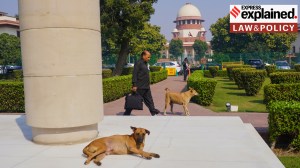On commuting death,SC walks the tightrope
Recent decisions show Apex court torn between empathy for condemned and law.
As the eight-week wait for the governments response on the delay in execution of death sentences of the killers of Rajiv Gandhi starts,a series of Supreme Court decisions show a court torn between empathy for the condemned man and an inability to lay down hard and fast rules on the executive to prevent the delay.
The judgments reveal that the judiciary is generally empathetic about the plight of the death row convict waiting in his cell for death haunted by the brooding horror of hanging,but skids to a halt to conclude that every case is individual.
In his 2009 verdict in Jagdish Deo Pandey versus State of Madhya Pradesh,Justice H S Bedi says that as per the latest position in law,no hard and fast rules can be laid down with respect to the delay which could result as a mitigating circumstance,and each case must depend on its own facts.
But a deep concern about the psychological impact of executive delay on the condemned man is voiced over and over again by the Supreme Court.
For example,in the Constitution Bench decision in 1989 in Triveniben versus State of Gujarat,the majority judgment describes the condemned mans uncertainty as between the funeral fire and mental worry,it is the latter which is more devastating,for,funeral fire burns only the dead body while the mental worry burns the living one.
A three-judge Bench in the Sher Singh and Others versus State of Punjab quotes from the sociological study called Condemned to Die,Life Under Sentence of Death by Robert Johnson in its judgment,saying some death row inmates,attuned to the bitter irony of their predicament,characterise their existence as a living death and themselves as the living dead.
But as if to self-check this outflow of compassion for the condemned man,the court attempts a balance by justifying that it has been universally recognised that a condemned person has to suffer a degree of mental torture even though there is no physical mistreatment and no primitive torture. He may be provided with amenities of ordinary inmates in prison,but nobody could succeed in giving him peace of mind.
Justice Bedis 2009 decision comes in the face of a 1974 decision by his predecessor Justice Krishna Iyer in Ediga Anamma (a 24-year-old woman) versus State of Andhra Pradesh.
The court substituted death penalty with life considering the fact that Anamma was a rustic young woman,flogged out of her husbands house by her father-in-law,was living with her parents with her only child though she had committed a premeditated,cleverly planned murder of another young woman and her child because of rivalry between her and the murdered woman for the affections of an illicit lover.
In this case,the Supreme Court had held that a delay of two years for execution was permissible,but beyond that the death penalty should be converted to life. This,Justice Iyer said,was only humane.
What may perhaps be an extrinsic factor but recognised by the Court as of humane significance in the sentencing context is the brooding horror of hanging which has been haunting the prisoner in her condemned cell for over two years, the court described Anammas mental state.
A series of four decisions in 1980s capture the changing judicial outlook on the commutation of death penalty because of prolonged delay by executive in executing the sentence.
In 1983,the Supreme Court said a condemned man can ask for commutation if two years have lapsed since he was sentenced to death by a trial court.
The same year saw the SC contradict itself in the Sher Singh case when it said the two-year benchmark is not a good enough reason and every case has to be decided individually in the context of the nature of offence committed and the period of delay.
Singh was described as the brain behind a cruel conspiracy to impersonate a Customs officer who pretends to question unsuspecting visitors to the city of Madras,abduct them on the pretext of interrogating them,administer sleeping pills to the unsuspecting victims,steal their cash and jewels and finally murder them.
But in 1985,the Supreme Court was back to square one. In the Javed Ahmed Abdul Hamid Pawala versus State of Maharashtra case law,the court said a 2.9 years delay,unblemished jail records and sentence of death heavily weighing on the mind of the death row convict would entitle him to seek commutation.
In 1989,the court agreed that the three decisions were conflicting each other and decided to clear the air through the Triveniben case by forming a Constitution Bench to lay down five dos and donts (see box) for the judiciary while considering a plea for commutation.
Dos & Donts
1 Delay can only be computed from the time the judicial process has come to an end. It meant that any delay on the judicial side did not count as delay.
Justice Jagannatha Shetty,a member of the Constitution Bench,reasoned that this was because the time taken in the judicial proceedings by way of trial and appeal was for the benefit of the accused. It was intended to ensure a fair trial to the accused and to avoid hurry-up justice.
2 The only delay which would be material for consideration will be the delay in disposal of the mercy petition or delays occurring at the instance of the executive.
3 The nature of the offence and the circumstance in which it was committed will have to be taken into account.
4 It may be open to the court to consider or examine any circumstances after the final verdict was pronounced if considered relevant.
5 Conduct of the prisoner after the final verdict cannot be considered for coming to the conclusion whether the sentence could be altered on that ground also.



- 01
- 02
- 03
- 04
- 05




























